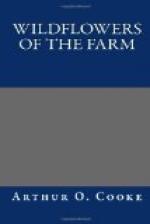[Illustration: PIMPERNEL.]
The blossoms of the Pimpernel close up when rain is near, and it is often called the Poor Man’s Weatherglass. Sometimes, but very rarely, a plant is found which has pink, or even pure white blossoms. There is also a blue Pimpernel. Another Pimpernel is the Bog Pimpernel; but we shall not find it in this dry field of corn, as you may guess by the name.
One more flower we will look at, and then it will be time to leave our corn-field and to search elsewhere. Growing on the hedgebank at the side of the field is a pretty lilac-blue flower on a long bare stalk. It is the Field Scabious.
The blossoms are in shape like a round ball very much flattened—like a round pincushion. There are no large petals here, as with the Poppy, but a great number of small florets. Those on the outer edge of the blossom are larger than those inside. Each floret is a tiny tube or pipe.
The leaves are on separate stalks from those which bear the flowers, and they grow in pairs. They are divided into several pairs of lobes, with a single lobe at the end of each leaf. Some leaves grow from that part of the stem which is underground, and these are larger than the others, and are sometimes of a different shape. Both the leaves and the stem are hairy.
CHAPTER XI
ON THE CHASE
We have now seen a good many Flowers of the Farm; we have found them in the coppice, on the garden wall, and in the fields. To-day we will go a little further off, three miles away.
You say, “Surely that is a long way off for the farmer to have a field.” It is not exactly a field. The Chase is a great open common or moor, which belongs to the village or parish where Willow Farm is. Nearly all the people of the village have certain rights of pasturage on it; they may let their horses and cattle and sheep graze there. Every now and then Mr. Hammond sends some of his sheep to the Chase to feed there for a few weeks. It is very high dry ground, and that is good for sheep.
The road runs through the middle of the great common without any hedge or fence on either side. There are horses and sheep and cattle here on this May morning; donkeys too. All the sheep are marked, and we soon see some which belong to Willow Farm; they are stamped on the back in large letters “W.H.” for William Hammond. A farmer easily knows his own horses and cows; sheep are less easy to recognise, and are usually marked.
[Illustration: GORSE.]
One of the flowers of the Chase we see at once. In whatever direction we look across the common there is a perfect blaze of gold—the blossoms of the prickly Gorse or Furze. Spring is the time to see its mass of golden yellow blossoms best; but I do not think there is a week, or even a day, in the whole year when some of the flowers are not out. Did you ever hear the saying, “Kissing is out of season when the Gorse is out of bloom.” That is never!




